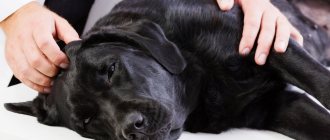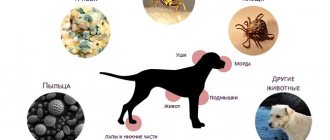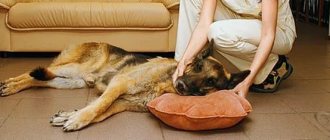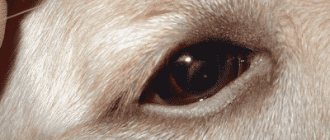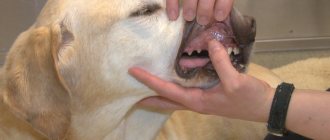Causes of diarrhea and vomiting in dogs
Diarrhea and vomiting in dogs occur for various reasons. Let us consider in detail the main diseases of dogs, accompanied by vomiting and diarrhea.
Infectious diseases
Vomiting white foam and diarrhea in puppies are in most cases signs of infection. Adult animals become infected less frequently and tolerate the disease more easily.
Here are the viral and bacterial diseases that are accompanied by vomiting and diarrhea in dogs:
- Parvovirus enteritis. The dog is lethargic and refuses food. Characterized by watery, yellow stools with an unpleasant odor. After some time, diarrhea with blood appears. Body temperature drops, dehydration and coma occur. The disease develops quickly; without treatment, the animal may die on the 3-4th day. High mortality rates occur in puppies.
- Rotavirus enteritis. The infection is dangerous for young dogs. Signs: debilitating diarrhea. Body temperature rises and then falls. The illness lasts 8-10 days.
- Distemper (distemper) of dogs. The intestinal form of plague is characterized by an increase in body temperature up to 41 ° C, discharge from the eyes and nose, photophobia, loss of appetite, and diarrhea.
- Adenoviral infection. This disease causes diarrhea, fever, and enlarged liver. Characterized by an obsessive cough that turns into vomiting.
- Rabies. With rabies, excessive salivation, paralysis of the lower jaw, and problems with swallowing develop. The animal has a perversion of appetite - the dog swallows inedible objects and refuses water. Characterized by changes in behavior, photophobia, and inadequate reaction to loud sounds.
- Bacterial intestinal infections (colibacillosis, salmonellosis, clostridiosis, campylobacteriosis) - increased body temperature, apathy, refusal to feed, diarrhea.
Infectious diseases are characterized by a sharp onset, an increase in the animal’s body temperature, refusal of food and severe weakness. The stool is very liquid, mixed with mucus, often yellow in color and with a foul odor.
Poisoning
Vomiting and diarrhea in dogs develop if poison gets into the stomach. The disease is characterized by an acute onset. The pet regurgitates what it has eaten, then the dog vomits mucus and foam. Sometimes it is noted once, more often 2-4 times. When intoxicated with certain substances, repeated vomiting develops, uncontrollable, like a fountain .
If an animal is poisoned, other symptoms are observed:
- diarrhea;
- muscle tremors;
- convulsions;
- pupil dilation;
- loss of vision;
- dehydration;
- severe weakness;
- dyspnea.
In case of poisoning by rat poison, the dog's blood clotting decreases, bleeding gums develop, bleeding from the nose and anus.
Vomiting in dogs also occurs when intoxicated with toxic fumes, if the pet has inhaled gasoline, household chemicals, or paint products.
Pathologies of the digestive system
Vomiting is a common sign of non-contagious diseases of the stomach and intestines:
- Gastritis (inflammation of the stomach lining). Occurs immediately or shortly after feeding. With palpation, you can determine pain in the upper abdomen.
- Stomach ulcer.
- Hepatitis (liver inflammation). In addition to vomiting, the dog has white diarrhea, icteric discoloration of the whites of the eyes, and dark urine.
- Cholecystitis (inflammation of the gallbladder). There may be an admixture of bile in the vomit. Acute attacks of pain in the right hypochondrium.
- Inflammation of the pancreas (pancreatitis). Nausea occurs in the morning before feeding. The disease is accompanied by pain in the right hypochondrium.
The vomit may contain a lot of mucus, bile or blood. The dog's appetite is poor, and sometimes there is a perversion of taste. Diseases of the digestive system are accompanied by changes in the consistency and color of stool (hard, liquid, mushy), weight loss, and attacks of abdominal pain.
Feeding errors
Isolated cases of regurgitation may occur due to eating inappropriate food. It appears in the following situations:
- Overfeeding.
- Stale food.
- If your dog is vomiting white foam, the cause may be a long break in feeding. An empty stomach produces more mucus, which mixes with the air to form bubbles.
- Unsuitable food for dogs: fatty, salty, smoked, sweets, onions, garlic, legumes, sweet fruits (bananas, figs, grapes, dried fruits).
- Change of food. In this case, diarrhea is a sign of a food allergy.
- Foreign body in the stomach. Dogs often regurgitate hairballs or grass they eat. There's nothing wrong with that. Less often, something dangerous gets into the stomach - small parts, plastic, items of clothing, toys.
- Small breed dogs are prone to episodes of vomiting due to the structure of the digestive system and increased nervous excitability.
- Dogs with short muzzles - boxers, mastiffs, bulldogs - produce a lot of saliva. In this case, saliva is difficult to swallow, the animal slurps, and foam forms, which inexperienced owners confuse with belching.
Dogs have a very developed gag reflex. Regurgitation of food is an excellent protective mechanism provided by nature. Therefore, one-time episodes of vomiting do not cause harm to the animal.
Other causes of vomiting
White vomiting in a dog is observed with epilepsy during an attack.
Regurgitation can also serve as a sign of helminthic infestation. In this case, it is irregular, appearing more often in the morning. The animal has other signs of helminthiasis:
- diarrhea alternating with constipation;
- bloating;
- pallor of the mucous membranes;
- exhaustion;
- dull fur.
Sometimes parasites or their fragments are found in vomit, in stool or around the anus.
The cause of vomiting in a dog can be a head injury, overheating, or sunstroke.
Why is vomiting dangerous?
Vomiting is the body’s response to any disturbance. The protective property of this natural mechanism is to remove unnecessary or dangerous food from the stomach. But repeated nausea is harmful:
- Exhausting leads to dehydration. This is especially dangerous for young dogs. If the puppy vomits foam, then it is necessary to monitor the replenishment of fluid.
- If stomach contents enter the trachea, the dog may suffocate. The risk of aspiration increases if the animal is unconscious.
- Together with vomit, the body loses electrolytes - sodium, potassium, chlorine. This leads to disruption of the acid-base balance.
Frequent nausea is a sign of severe intoxication of the body.
The color of the burp may indicate characteristic disorders:
- White with foam - the stomach is empty, there is a lot of mucus in it.
- Vomiting blood is typical for poisoning with rat poison, stomach ulcers, mechanical damage due to injuries, or ingestion of sharp objects. If the blood is bright red, it indicates bleeding from the esophagus or mouth. Vomit turns coffee-colored if blood flows from a stomach ulcer.
- Yellow, green - an admixture of bile. The reflux of bile into the stomach occurs with severe intoxication and liver disease.
Any vomiting other than one-time regurgitation of food requires consultation with a veterinarian.
Prepare before going to the vet
In the office, you may have to provide the veterinarian with all possible assistance (hold the animal while they take blood for analysis, give an injection, extinguish aggression, calm your voice, scratch its ears, stroke it). If you know that you are terrified of blood, IVs, or definitely cannot withstand the type of medical interventions, then perhaps you should ask a friend or relative for help.
Find a veterinary certificate, veterinary passport.
Take:
- Leash;
- Collar;
- Muzzle;
- Carrying;
- A pack of napkins;
- litter;
- Bowl, water (at the veterinarian's discretion)
Prepare answers to possible questions from the veterinarian:
- Are all vaccinations up to date on the animal?
- Pet’s behavior in recent days, appetite;
- His diet;
- What drugs and medicines did you give to the animal;
- Latest test data (if available).
It’s better to make an appointment in advance - you’ll save time and be able to calculate when you’ll have to take time off. This does not apply to life-threatening situations where you will have to take an animal to a veterinary clinic without an appointment.
Be affectionate with your pet, play, talk to him. You can take his favorite toy with you so that while you wait for your turn at the reception, you can distract your friend from the new environment.
Furry, feathered or scaly ones also need to be prepared. No matter how much you want to treat your little one with something tasty, remember: you need an empty stomach. Feeding is prohibited!
You can wash your animal without using detergents. But it is important not to touch your pet if there is nasal discharge, watery eyes, salivation (salivation), dandruff, scratching, rashes, skin scabs, loss of hair/feathers/scales, wounds and other external manifestations of a potential disease.
If the veterinarian has instructed, collect the animal’s urine in a sterile container, and pick up the feces with a stick (no blades of grass, specks, or debris). Transfer the feces into a sterile container. Send to the biochemical laboratory within 6 hours. The feces are examined for eggs of roundworms, pinworms, tapeworms, liver flukes, echinoccus, alvecoccus, pork tapeworm, bovine tapeworm, and gastrointestinal bleeding is detected.
At the veterinary hospital, the animal’s blood will be analyzed for antibodies to allergens, viruses, bacteria, and parasites.
Games on feelings
In real veterinary clinics there will be elements of “divorce”.
Veterinarians say that this is often determined by the client’s wallet. The greater the opportunity to pay for services and the more the owner worries about his pet, the more likely the animal will be prescribed additional immunostimulants, dietary supplements, water-soluble and fat-soluble vitamins, and special food. There are cases when this is really necessary (pedigreed, show animals, weakened after a serious illness). But it will be good if you ask your veterinarian in detail about the need for each appointment. Find out in detail about the results of the examination and analysis of your pet’s condition. Be persistent. Do not give in to attempts to intimidate you, be consistent in your questions. Consult a specialist who does not work at this veterinary clinic. If it turns out that half of the prescriptions are prescribed to enrich the veterinarian’s pocket, and not for the health of the animal, feel free to leave. And do not forget to leave a negative review about the organization - other owners may also suffer.
How to help a dog vomiting white foam?
If vomiting occurs, the owner can relieve the pet's condition. But first of all, it is necessary to establish the cause of the pathology. What you can do if your dog is burping foam:
- remove the collar, muzzle;
- Provide the dog with plenty of fluids;
- give enterosorbents;
- Make sure that the dog does not suffocate from vomit entering the respiratory tract (hold the head, clean the oral cavity).
If your dog has vomited several times, you should contact your veterinarian . Otherwise, valuable time will be lost, since nausea may be a symptom of infection or poisoning.
What not to do
If your dog is vomiting water and white foam, you should not do the following:
- scold an animal;
- give your dog medications for vomiting and diarrhea without consulting your veterinarian;
- force-feed;
- offer food earlier than 2-3 hours after an episode of vomiting.
Even after a single burp, the dog is transferred to dietary feeding for at least 24 hours.
Prevention
It is better to prevent problems, so prevention of gastrointestinal diseases is important. It is divided into two areas: care and education. Here are some practical recommendations:
- Monitor the animal's diet. Food should be suitable and fresh, avoid sudden changes in diet.
- Prohibit picking up small pieces of food on the street or from the floor, or rummaging through trash cans. There is a high risk of choking on a foreign body, getting injured by a bone, or eating a stale or toxic product.
- If the dog does not obey and grabs everything edible on the street, put a muzzle on it.
- Every 3-4 months carry out prophylaxis against worms.
- Get a rabies vaccination every year.
- Be careful when using household chemicals and medications. The dog should not have access to them.
- Get used to transportation gradually; if the animal is very sick, transport it on an empty stomach.
And the main means of prevention is attentiveness. Observe your pet, its appetite and well-being; most often, the dog’s changed behavior indicates a developing problem. Carry out preventive examinations; timeliness is an excellent weapon in the fight against diseases.
Periodic vomiting should not be a cause for concern; it is one of the protective mechanisms of the animal body. But if the phenomenon is accompanied by other alarming symptoms and continues for several days, there is no need to postpone a visit to the doctor.
Sources
- https://ya-vet.com/gastroenterolog/rvota-u-sobaki-beloj-penoj-lechenie
- https://dog-care.ru/zdorove/bolezni/rvet-beloy.html
- https://DogBuldog.ru/sobaki/zdorove/sobaku-rvet-beloj-penoj-so-slizyu-4795/
- https://prosobak.net/sobaku-rvet-beloj-penoj/
- https://www.PorodiCobak.ru/zdorove-i-bolezni/sobaku-rvet-beloj-penoj-chto-delat-hozyainu
- https://kinpet.ru/pochemu-sobaku-rvet-beloy-penoy-i-kak-ey-pomoch/
- https://tvoidrug.com/health/bolezni/rvota.html
- https://vashipitomcy.ru/publ/sobaki/bolezni/sobaku_rvet_penoj_osnovnye_prichiny_i_sposoby_lechenija/26-1-0-1585
- https://dogworry.ru/veterinariya/u-sobaki-rvota-beloj-penoj-lechenie.html
- https://usobaki.com/rvota-beloy-penoy/
[collapse]
Treatment for vomiting with white foam
If your dog is diarrhea and vomiting, you should be examined by a veterinarian. The doctor prescribes treatment. It includes treatment of the underlying disease and elimination of painful symptoms.
Drugs used for vomiting in dogs:
- Attacks of vomiting are stopped if they are debilitating and threaten dehydration. The dog is injected with Cerucal solution intramuscularly at the rate of 0.7 ml per kg of weight.
- Drotaverine. Antispasmodic, relaxes the smooth muscles of the stomach, relieves spasms and pain. Used at a dosage of 40 mg per kg of weight.
- Omez. Tablets or capsules. Reduces the acidity of gastric contents. Dosage 0.5-1.0 mg per kg of dog weight 1-2 times a day.
- Hydrovit, Regidron. Oral rehydration products restore water balance. The powder is diluted in water and given to the animal little by little during the day from a syringe or from a spoon at the rate of 10–20 ml per kg of weight. You can make an analogue of the solution yourself: for 1 liter of boiled water you will need 1 tbsp. l. sugar, 1 tsp. soda and 1 tsp. table salt.
Enterosorbents remove toxins, gases, and excess bile from the stomach and intestines. Give them 3 – 6 times a day. For diarrhea and vomiting, dogs are prescribed the following sorbents:
- Smecta. Powder. Dilute according to instructions, give 1-2 tsp. solution per 10 kg of weight per dose.
- Polysorb. Powder. Dose 0.2-0.3 g per kg of dog weight per day, this amount is divided into 4 doses. Before use, the drug is diluted in a small amount of water.
- Enterosgel. Give from 1 to 15 ml (depending on the weight of the animal) 3 times a day.
Anti-vomiting medications should not be given for ulcers or bleeding in the gastrointestinal tract.
What to do: take it to the vet or treat it yourself
To prevent further absorption of toxic substances, after vomiting, the animal should be given activated carbon or other adsorbents to drink. The owner’s actions should depend on the cause of the pathology:
- A small amount of white foam accumulating at the corners of the mouth indicates exhaustion. In this case, the owner can handle it on his own. It is necessary to review your pet's diet and reduce the time between feedings.
- If there are worms in the foam, you should seek help from a veterinarian. The doctor will prescribe anthelmintic drugs depending on the body weight and age of the pet.
- In case of stomatitis or oral trauma, which can lead to the formation of white foam, it is worth examining the animal's mouth. When the mucous membranes of the oral cavity are affected, the dog coughs up blood. It is necessary to remove foreign bodies from the wounds and treat them with a disinfectant solution. With the development of a purulent-inflammatory process, the dog will need antibiotics and special ointments for wound healing. They must be prescribed by a veterinarian.
- During an epileptic seizure, you need to place the dog on its side, slightly holding its head above the floor. When the dog coughs up, you need to tilt his mouth down a little to facilitate the passage of vomit. The animal's body may be shaken by convulsions, so it is necessary to free the space from foreign objects. The dog can get hurt on them. After the attack passes, you need to take the dog to the veterinary clinic, where the pet will be prescribed anticonvulsant drugs.
- If the dog is poisoned, you need to give the dog adsorbents and give enemas. To prevent dehydration, it is recommended to call a veterinarian at home. The specialist will put in a drip with saline solution.
- If you suspect rabies, you must isolate your pet, call a veterinarian, or take it yourself to a clinic for euthanasia.
- Plague is caused by pathogenic microorganisms - Yersinia. To eliminate them, antibiotics and immunostimulants are needed. Treatment should be carried out by a veterinarian. You can give your dog multivitamin complexes on its own.
What to feed your dog for vomiting and diarrhea?
In case of poisoning, a fasting diet of 24 hours is recommended. For other diseases, follow the advice of a veterinarian.
You cannot force feed a dog if it does not eat and is vomiting and having diarrhea.
In any case, feeding restrictions are adhered to for 1-3 days after an episode of vomiting.
Dietary products for dogs are:
- broths;
- rice water;
- skim cheese;
- boiled eggs;
- boiled lean meat;
- boiled vegetables (carrots, pumpkin).
Fermented milk products are given on the recommendation of a veterinarian . Gradually, porridge (rice, rolled oats, buckwheat), vegetables, and offal are included in the pet’s diet.
Feed a sick dog 3-5 times a day in small portions. The food should be at room temperature.


